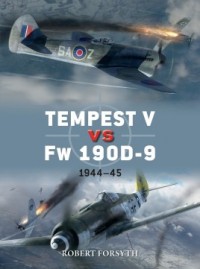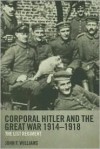Currently reading
Gabriela, Cravo e Canela
Progress:
157/358 pages
Seven Pillars of Wisdom: A Triumph (The Authorized Doubleday/Doran Edition)
Progress:
189/672 pages
The Creature from Jekyll Island: A Second Look at the Federal Reserve
Progress:
41/608 pages
Peter the Great
Progress:
472/934 pages
Under the Loving Care of the Fatherly Leader: North Korea and the Kim Dynasty
A Time for Trumpets: The Untold Story of the Battle of the Bulge
Progress:
191/712 pages
The German Army 1933-1945
Progress:
198/598 pages
Corporal Hitler and the Great War 1914-1918: The List Regiment
Progress:
22/238 pages
TWO EAGLES GRAPPLING IN THE CENTRAL BLUE, 1944-45

For the aviation enthusiast, this is an absolutely first-rate book shedding considerable light on 2 Second World War fighter planes which represented the acme in the development of piston-engined combat aircraft.
The Hawker Tempest V represented an advancement on the Hawker Typhoon, which though originally designed as a successor to the Spitfire, proved to be ideal as a low-level ground attack fighter-bomber. Entering service with the Royal Air Force (RAF) early in 1944, the Tempest V proved adept at combating the German V1 'flying bombs' that were unleashed against Britain during the late spring and summer of 1944. Subsequently, they were employed on the European continent where they came into their own as both an amazingly fast ground attack aircraft, as well as in the purely fighter interceptor role.
The Focke Wulf 190D-9 represented an intermediate advancement on the Focke Wulf 190A-8 fighter with an extended fuselage (necessitated by the introduction of the elongated Junkers Jumo 213A engine), along with a number of other modifications that made it one of the most potent and redoubtable fighters in Luftwaffe service. It would be deployed with a number of Luftwaffe fighter units in Germany and the Western Front during the late summer of 1944. But it wasn't until December of that year, that the FW 190D-9 clashed for the first time with the Tempest V in the skies of Western Europe. It was the first of many contentious encounters between both fighters until V-E Day in May 1945.
Other hallmarks of this book are the rich assortment of illustrations and photos, as well as chapters describing in considerable detail the characteristics of both fighters in addition to the flight training programs devised by the RAF and Luftwaffe in training pilots who would go on to fly the Tempest V and FW-190D-9 in combat. For 80 pages, this book packs a lot and comes HIGHLY RECOMMENDED.
The Hawker Tempest V represented an advancement on the Hawker Typhoon, which though originally designed as a successor to the Spitfire, proved to be ideal as a low-level ground attack fighter-bomber. Entering service with the Royal Air Force (RAF) early in 1944, the Tempest V proved adept at combating the German V1 'flying bombs' that were unleashed against Britain during the late spring and summer of 1944. Subsequently, they were employed on the European continent where they came into their own as both an amazingly fast ground attack aircraft, as well as in the purely fighter interceptor role.
The Focke Wulf 190D-9 represented an intermediate advancement on the Focke Wulf 190A-8 fighter with an extended fuselage (necessitated by the introduction of the elongated Junkers Jumo 213A engine), along with a number of other modifications that made it one of the most potent and redoubtable fighters in Luftwaffe service. It would be deployed with a number of Luftwaffe fighter units in Germany and the Western Front during the late summer of 1944. But it wasn't until December of that year, that the FW 190D-9 clashed for the first time with the Tempest V in the skies of Western Europe. It was the first of many contentious encounters between both fighters until V-E Day in May 1945.
Other hallmarks of this book are the rich assortment of illustrations and photos, as well as chapters describing in considerable detail the characteristics of both fighters in addition to the flight training programs devised by the RAF and Luftwaffe in training pilots who would go on to fly the Tempest V and FW-190D-9 in combat. For 80 pages, this book packs a lot and comes HIGHLY RECOMMENDED.













